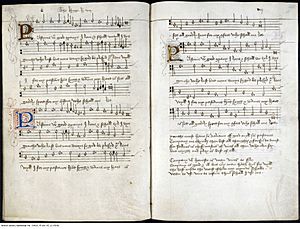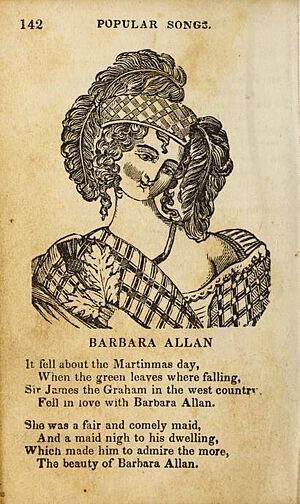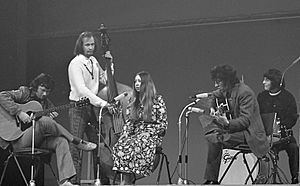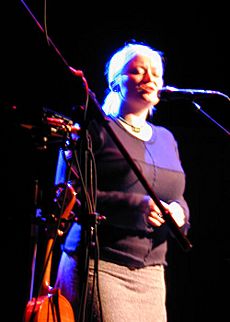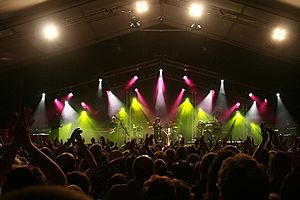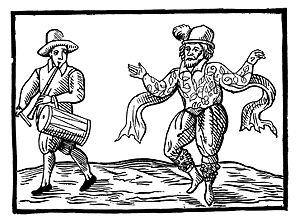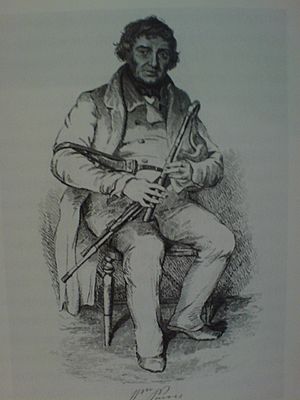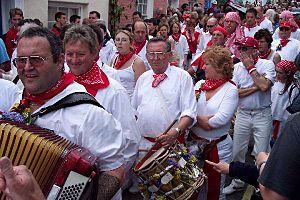English folk music facts for kids
English folk music is a type of music that has been around for a very long time, since the medieval period. It's different from fancy classical music or pop music you hear today. Folk music was usually shared by people singing it to each other, passing it down through families and communities. Later, printed books and recordings helped share these songs even more. The term "folk music" can mean old traditional songs or new songs made in a similar style.
Different parts of England have their own special folk music styles, especially in places far from big cities like Northumbria or the West Country. English folk music has also mixed with music from Scotland. When English people moved to countries like the United States, Canada, and Australia, they took their songs with them. Many of these old songs are still sung by those communities today.
English folk music has given us many cool things like sea shanties (songs sailors sing), jigs and hornpipes (types of dances), and the music for Morris dancing. It has also mixed with other music styles, like classical and rock music. This mixing created new types of music such as British folk rock, folk punk, and folk metal. Today, there's still a lively group of people who love English folk music. It keeps influencing other music and sometimes even becomes popular again.
Contents
- History of English Folk Music
- Folk Clubs: Places to Play and Listen
- Folk Music on the Radio
- Folk Festivals: Big Music Parties
- Types of English Folk Music
- Ballads: Story Songs
- Carols: Festive Songs
- Children's Songs: Rhymes and Lullabies
- Hornpipes: Lively Dance Tunes
- Jigs: Energetic Dances
- Morris Dance: Traditional English Dance
- Protest Songs: Singing for Change
- Sea Shanties: Sailors' Work Songs
- War Songs: About Battles and Soldiers
- Work Songs: Music for Tasks
- Regional Folk Traditions
- See also
History of English Folk Music
How Folk Music Started
Folk music in England has been around since the Anglo-Saxon people arrived after 400 AD. In old times, people would sing songs and play instruments at parties. We don't know much about these very old songs because they weren't written down. Some dances, like Morris dance, might come from this time. We know that songs about Robin Hood were sung by the late 1300s. The oldest detailed songs we have are Robin Hood ballads printed around 1495.
From the 1500s to the 1700s
Even kings and queens in the 1500s enjoyed popular music. King Henry VIII might have even written the tavern song "Pastime with Good Company".
Over time, rich people started listening to different music, like classical music with instruments such as the lute and harpsichord. But ordinary people kept playing traditional music with instruments like the pipe, tabor, bagpipe, and hurdy-gurdy. The fiddle was special because it was used in both classical and popular music.
By the mid-1600s, some people started collecting popular songs. John Playford published The English Dancing Master in 1651. Famous diarist Samuel Pepys also collected songs and mentioned singing "Barbara Allen" in 1665. This song was still sung by people hundreds of years later!
In the 1700s, more collections of "folk" music appeared, influenced by the Romantic movement. These included Wit and Mirth (1719–20) by Thomas D'Urfey and Reliques of Ancient English Poetry (1765) by Bishop Thomas Percy. During this time, English folk music also traveled across the Atlantic Ocean with settlers and became a key part of American traditional music. It mixed with other styles to create new genres like bluegrass and country music.
Early 1800s: Industrial Changes
When the Industrial Revolution began, songs started to change. Instead of just being about farm life, they included work songs about factories and mines. People realized that old songs were being forgotten, so they became interested in collecting them again. Important collections from this time include Christmas Carols Ancient and Modern (1833) by William Sandys.
New technology brought new instruments like silver and brass bands, especially in industrial cities. New types of music also appeared, like the Music hall from the 1850s. Music hall shows became very popular and were a main source of English popular music for over a century.
Folk Revivals: 1890s to 1960s
From the late 1800s, people started trying to find, record, and save English folk music and dances. These efforts are called "folk revivals."
The first revival happened in the late 1800s and early 1900s. People like Sabine Baring-Gould and Cecil Sharp collected many songs. Francis James Child's huge collection, The English and Scottish Popular Ballads (1882–92), became very important. Cecil Sharp also started the English Folk Dance Society. This revival influenced classical composers like Ralph Vaughan Williams, who used traditional songs in their music. In 1932, the Folk-Song Society and the English Folk Dance Society joined to become the English Folk Dance and Song Society (EFDSS). Some of these collectors even recorded songs on old wax cylinders!
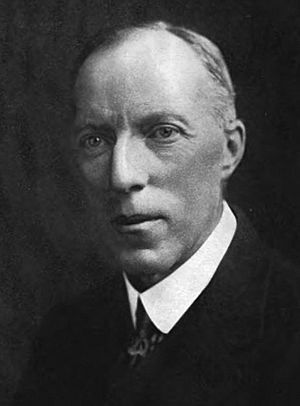
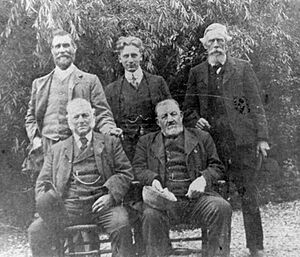
The second revival started after World War II. People worried that new music styles would make traditional music disappear. Key figures were Ewan MacColl and A. L. Lloyd. This revival focused more on work songs from the 1800s. Topic Records, started in 1939, released many folk recordings. This led to many folk clubs opening in towns from the 1950s. Famous traditional performers included The Watersons and Shirley Collins. Some musicians, like Davy Graham and Martin Carthy, mixed English folk with American music to create a guitar style called 'folk baroque'.
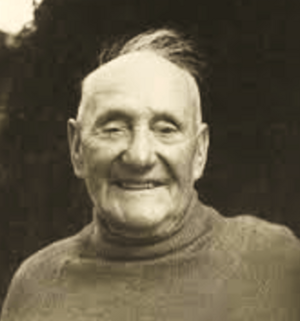
Many people learned old songs directly from their communities. These "traditional singers" like Sam Larner and Harry Cox were highly respected. Their songs became the basis for many popular folk revival musicians. Today, there are large collections of English folk songs, like the Roud Folk Song Index and the Vaughan Williams Memorial Library.
Progressive Folk Music
Mixing American music with English folk also led to progressive folk music. This style tried to make folk music more complex with better playing and arrangements. Many progressive folk artists, like Pentangle, still used traditional elements. Others, like Donovan and the Incredible String Band, added influences from medieval or Eastern music.
In the late 1960s and early 1970s, progressive folk had a brief moment of popularity. Bands like the Third Ear Band and Quintessence explored different sounds. Some of the best individual artists were Nick Drake and John Martyn. They were like early "singer-songwriters" who mostly played acoustic music and wrote their own songs. Ralph McTell was very successful with his song "Streets of London" in 1974.
British Folk Rock

British folk rock started in the mid-1960s with bands like Fairport Convention and Pentangle. They combined traditional music with rock instruments. It was very popular in the 1970s with groups like Steeleye Span and the Albion Band. This style also spread to other Celtic cultures like Brittany and Ireland, creating Celtic rock. It influenced music in the US and Canada and led to Medieval folk rock, folk punk, and folk metal. Although its popularity went down in the 1980s, it has seen a comeback since the 1990s.
Folk Punk and Folk Metal
In the mid-1980s, English folk music had another rebirth, mixing folk with the energy and political anger of punk rock. Bands like The Pogues, The Men They Couldn't Hang, Oyster Band, and Billy Bragg were leaders. Folk dance music also became popular. Later, the band Edward II & the Red Hot Polkas even mixed folk with reggae.
Similar to how folk rock started, the English thrash metal band Skyclad added violins to their 1990 album. People liked it, so they got a full-time fiddle player and created folk metal, which then spread to other countries.
Traditional Folk Comeback: 1990s to Today
Traditional English folk music was very popular in the mid-1970s. But by the end of that decade, its popularity dropped as new music like punk and electronic music took over. However, things started to change in the 1990s with a new generation of musicians. Artists like Kate Rusby, Bellowhead, Nancy Kerr, Kathryn Tickell, Seth Lakeman, and Eliza Carthy became popular. They mostly played traditional acoustic music.
This comeback was also helped by the creation of the BBC Radio 2 Folk Awards in 2000. These awards gave folk music more recognition. Today, folk music in England is as popular as it has been in a long time.
Folk Clubs: Places to Play and Listen
Folk clubs are places where people gather, usually in a pub, to perform and listen to traditional folk music. They became very popular after a short-lived music craze called "skiffle" in the mid-1950s. Many of these clubs then started focusing on English traditional folk music. By the mid-1960s, there were over 300 folk clubs in Britain!
Most clubs met weekly in the back room of a pub. They were known for having many amateur performers, but also "residents" who played regularly. Many of these residents, like Martin Carthy and Shirley Collins, later became famous musicians. Even comedians like Billy Connolly started their careers in folk clubs. The number of clubs went down in the 1980s, but they started to grow again in the mid-1990s. Now, there are over 160 folk clubs in the UK.
Folk Music on the Radio
It has always been hard for folk music to get on TV in England. So, radio has been very important for sharing folk music with more people. The EFDSS sponsored a BBC radio show called As I Roved Out from 1952 to 1958. This show played recordings of folk music and helped many people discover it.
Other important radio shows included Ewan MacColl's Radio-ballads (1958–64). John Peel often played folk music on his Radio One show in the late 1960s. The most consistent source of folk music on the radio has been BBC Radio 2. Shows like "Folk on Friday" and "Folk on Two" have been on the air for decades, helping folk music reach a wide audience.
Folk Festivals: Big Music Parties
Folk festivals started around 1950, often focusing on dance. The Sidmouth Festival began in 1955. The EFDSS used to organize these festivals, but now most are run locally. One of the biggest and most famous English folk festivals is the Cambridge Folk Festival, which started in 1965 and attracts about 10,000 people.
Probably the largest festival is Fairport's Cropredy Convention, which started in 1979. It features folk, British folk rock, and rock artists, and now attracts up to 20,000 people each year. Like rock festivals, folk festivals have become more common since the 1990s. There are now over a hundred folk festivals of different sizes held in England every year.
Types of English Folk Music
Ballads: Story Songs
Ballads are songs that tell a story. Many ballads were printed and sold on single sheets of paper. They often repeat parts of the story. Traditional ballads are thought to have come from traveling singers in medieval Europe. Ballads can be about many things: religion, magic, sad events, love, history, legends, or even humor. Many English ballads were brought to the New World by settlers and became part of American folk music.
Carols: Festive Songs
A carol is a festive song. Today, we mostly think of carols for Christmas. But long ago, there were carols for all seasons and festivals, not just Christian ones. They came from a type of circle dance with singing that was popular in the 1100s. From the 1300s, they were used as songs for parades, especially at Christmas, Easter, and other religious holidays. They became less popular after the Protestant Reformation banned many festivals. However, some famous carols like 'The Holly and the Ivy' were written then, and they became very popular again in the 1800s.
Children's Songs: Rhymes and Lullabies
The oldest children's songs in Europe are lullabies from the medieval period. We have records of short rhyming songs for children from soon after. But most nursery rhymes weren't written down until the 1700s.
The first English collections were Tommy Thumb's Song Book (before 1744) and John Newbery's Mother Goose's Melody (around 1785). These rhymes came from many places, including traditional riddles, proverbs, ballads, and even drinking songs. About half of the "traditional" English rhymes we know today were around by the mid-1700s. Some, like 'Twinkle Twinkle Little Star' and 'Mary Had a Little Lamb', have known authors. Children's songs are special because they are still passed down by word of mouth from parents to children, even though they are also written down.
Hornpipes: Lively Dance Tunes
The hornpipe is a style of dance music that might have gotten its name from an English instrument by the 1600s. In the mid-1700s, it changed to a faster rhythm and became very popular in theater shows. It's most famous for the Sailor's Hornpipe, but it's also used for many other country dances. Like many dances, it traveled to Scotland, Ireland, and America.
Jigs: Energetic Dances
Jigs are a style of dance music from England, used for lively dances with steps, turns, and jumps. The word "jig" comes from the French word 'giguer', meaning 'to jump'. It was a known dance in the 1500s. Jigs are often played in a fast 6/8 time. In the 1600s, the jig dance was adopted in Ireland and Scotland, where it became very popular and is now often associated with those countries.
Morris Dance: Traditional English Dance
Morris dance is a type of English folk dance, usually with music. Dancers perform rhythmic steps and figures, often using sticks, swords, or handkerchiefs. The name might come from "moorish dance," referring to Spanish dance styles. Morris dance seems to have been popular in England by the early 1600s, especially in country areas. It was stopped for a while during the English Civil War but came back after 1660. By the 1800s, it was declining, but collectors like Cecil Sharp recorded it, especially in the Cotswolds. This helped bring the tradition back to life.
Traditionally, Morris dance was played with a pipe and tabor or a fiddle. From the mid-1800s, instruments like the melodeon, accordion, and drums became common. Many tunes are linked to specific Morris dances. Morris dance continues today in different local styles like Cotswold morris and Border Morris.
Protest Songs: Singing for Change
Protest songs are songs that speak out against something unfair or wrong. One of the oldest English protest songs is from the Peasants Revolt of 1381: ‘When Adam delved and Eve span, who was then the gentleman?’ Songs about heroes like Robin Hood can also be seen as a subtle form of protest.
Later, groups like the Levellers in the 1600s sang more direct protest songs, like "The Diggers' Song". Songs against war also appeared, showing the human cost. As factories and industries grew from the 1700s, workers created industrial work songs. These included songs for miners like "The Black Leg Miner" and for factory workers like "The Factory Bell." These songs were often sung outside of work hours. In the 1980s, Billy Bragg became a leading voice of protest in Britain.
Sea Shanties: Sailors' Work Songs
Sea shanties are work songs traditionally sung by sailors. The word "shanty" comes from the French word 'chanter', meaning 'to sing'. They might be as old as the 1400s, but most recorded examples are from the 1800s.
Shanties were slow, rhythmic songs that helped sailors work together on ships. Many were "call and response" songs, where one sailor (the shantyman) sang a line, and the others sang a response. They came from different sources, including dances, folk songs, and even West African work-songs. Different shanties were used for different tasks, like pulling ropes quickly or turning a capstan for a long time. Famous shanties include 'Blow the Man Down' and 'Bound for South Australia'.
War Songs: About Battles and Soldiers
Songs about military and naval topics were a big part of ballad writing from the 1500s. One of the earliest British ballads, ‘The Ballad of Chevy Chase’, is about a battle in 1388. Conflicts with Spain in the late 1500s and early 1600s led to many ballads describing naval battles. The English Civil War (1642–1653) produced "Cavalier ballads."
The wars between England and France in the 1700s and 1800s led to more patriotic songs like ‘Heart of Oak’. As music halls became popular, folk songs stopped being about current wars in the late 1800s.
Work Songs: Music for Tasks
Work songs are sung while doing a task (often to help keep time) or are songs about a job or trade. In England, there are two main types:
- Agricultural work songs: These were rhythmic songs sung without instruments by people doing physical, repetitive tasks, like harvesting. They helped increase productivity and reduce boredom.
- Industrial folk songs: These appeared in Britain in the 1700s as workers adapted familiar music to their new experiences in factories and mines. Unlike farm work songs, these were often descriptive of the work or political. They were usually sung between work shifts or during free time, not during work, because early factories were too noisy. This type of song developed in textile factories, mines, and other industries.
Regional Folk Traditions
East Anglia: Coastal Songs and Melodeons

East Anglia (which includes Norfolk, Suffolk, and Essex) has many songs shared with the rest of Britain. Its long coastline means songs about the sea are very important here. This region, along with the West Country, was one of the first to widely use reed instruments like the melodeon from the mid-1800s. It also has an active tradition of step dancing.
In the second folk revival, many East Anglian folk musicians were discovered, including singers Sam Larner and Harry Cox, and fiddler Harkie Nesling. The Norfolk melodeon player and singer Tony Hall has a unique style. Famous folk artists from this region today include Billy Bragg and Beth Orton. East Anglia has many folk clubs and hosts festivals like the Cambridge Folk Festival, which is considered very important.
The Midlands: Industrial Heritage and Dance
The English Midlands (including places like Nottinghamshire, Derbyshire, and Warwickshire) were not as well-known for folk music at first. But now, a unique cultural heritage has been recognized, including many songs about the region's industrial past. The Midlands has strong traditions of ceremonial and social dance, especially in the south Midlands and Cotswolds, and the special Border Morris dance.
Famous folk artists from the Midlands include Anne Briggs and the Ian Campbell Folk Group. More recently, Martin Simpson from Lincolnshire is considered one of the best folk guitarists of his generation. Birmingham is also a center for folk music, home to the Birmingham Conservatoire Folk Ensemble. The region has many folk clubs and hosts major festivals in places like Shrewsbury and Warwick.
The North West: Ballads and Industrial Dance
North West England (including Lancashire, Cumbria, and Greater Manchester) has a rich history of ballads, some dating back to the 1600s. Lancashire was a common setting for folk songs. With different dialects and people from England, Scotland, and Ireland mixing here, the folk music has a special local character.
The Industrial Revolution greatly changed the region. In the south, cities like Manchester and Liverpool grew, leading to new traditions and folk songs linked to migration and work. These included processional dances and step dances, most famously clog dancing. These dances were different from those found elsewhere, but they are still a thriving tradition.
Ewan MacColl was a major figure from this region in the second folk revival. Harry Boardman did a lot to popularize and record the industrial folk songs of the North West. More recently, the region has produced performers like guitarist Ken Nicol and singer-songwriters Chris and Kellie While. The North West has many folk clubs and festivals, like the Fylde Folk Festival.
Northumbria: Pipes and Fiddles
Northumbria (the North East of England) has a very special style of folk music that is still thriving today. The region is famous for its unique Northumbrian smallpipes and a strong fiddle tradition that was already well-established in the 1690s. Northumbrian music has been influenced by southern Scotland and Ireland.
The Northumbrian Pipers' Society, founded in 1928, is credited with keeping this special tradition alive. Border ballads (songs from the border with Scotland) were a major part of collections by Francis James Child. In the second folk revival, performers like Louis Killen and The High Level Ranters brought Northumbrian folk music to national and international audiences.
More recently, Northumbrian folk music, especially the use of the Northumbrian pipes, has become one of the most lively and well-known folk styles in Britain. Artists like fiddler Nancy Kerr and piper Kathryn Tickell are famous worldwide. The region has over thirty folk clubs and hosts several major folk festivals.
The South East: Wassailing and Seafaring Songs
South-east England (excluding London and Sussex for this part) has been a very important area for English folk music. It kept strong traditions of wassailing (singing carols door-to-door) and seafaring songs were important in coastal counties like Kent and Hampshire.
In the first folk revival, collectors like George Gardiner and Lucy Broadwood found many songs here. In the second folk revival, Martin Carthy from Hertfordshire became a very important figure. The Oyster Band from Canterbury is a significant British folk rock group from this region. Today, prominent young folk musicians include Spiers and Boden from Oxfordshire and Chris Wood from Kent. The region has many folk clubs and festivals, including the Oxford festival.
London: Street Cries and Folk Hub
Even though London was the center of both folk revivals and the British folk rock movement, its own songs were often overlooked in favor of music from rural areas. London was the most common place mentioned in English folk songs, and it was the center for printing song sheets. From the 1600s to the 1800s, street singers were common in London, often selling printed versions of their songs.
London is home to the English Folk Dance and Song Society. The city's unique street cries (songs sung by street vendors) were not always considered folk music by collectors. Both Ewan MacColl and A. L. Lloyd moved to London in the 1950s, and it was where the first folk clubs started. Many folk musicians, like Ashley Hutchings and Richard Thompson (who formed Fairport Convention), moved to London to pursue their careers. More recent folk artists from London include Noah and the Whale and Mumford and Sons.
Sussex: A Rich Tradition
Sussex has had a big impact on English folk music. This is because it had a thriving tradition of folk dance, mummers plays (folk plays), and folk songs. It was also a rural county but close enough to London for collectors to visit easily. So, it was a rich place for collectors of the first folk song revival, like Kate Lee and Lucy Broadwood.
Sussex songs were used by classical composers like Percy Grainger and Ralph Vaughan Williams. The Copper Family of Rottingdean became very important for their knowledge of folk songs and later became major recording artists. Sussex folk music also influenced A. L. Lloyd. Other performers include Shirley Collins. Sussex has over twenty folk clubs and hosts annual folk music festivals.
The West Country: Celtic Influences and Sea Songs
Cornwall: Unique Dances and Language
The music of Cornwall is often similar to that of Brittany (in France) because of the close ties between the two areas. Some old songs and carols share the same roots. In the late Middle Ages, instruments like the fiddle, bombarde, bagpipes, and harp were used. The Cornish bagpipes disappeared but have recently been brought back. From the mid-1800s, accordions became very popular.
Cornwall has a long history of Cornish dances, including morris dancing, mumming, and guise dancing. These traditions were interrupted by wars but revived in the late 1700s. Some community events still survive, like the 'Obby 'Oss festival in Padstow and the Furry Dance in Helston. Famous folk songs include ‘Sweet Nightingale’ and ‘Lamorna’. 'Trelawny' is often sung at sporting events and is seen as an unofficial anthem. Some folk tunes now have Cornish lyrics written since the language revival in the 1920s.
The Rest of the West Country: Maritime Heritage
Outside Devon and Cornwall, Celtic influence is less obvious, but folk music in the West Country (including Somerset, Dorset, Wiltshire, and Gloucestershire) still has many unique local features. Like Cornwall, there are strong traditions of folk dance and mumming, with the Hobby horse celebrations at Minehead in Somerset being well-known.
Because of Devon's maritime history, sea shanties, hornpipes, and naval ballads are important parts of the regional folk music. From the 1800s, accordions have been a popular instrument. Folk songs from the West Country include ‘Widdecombe Fair’ and ‘Spanish Ladies’.
The region was important in the first folk revival. Sabine Baring-Gould collected many regional songs, published as Songs and Ballads of the West (1889–91). Cecil Sharp also collected songs from Somerset. In the second folk revival, famous West Country musicians included Bob Cann and Cyril Tawney. In the 1970s, a surprising music style called Scrumpy and Western emerged with bands like the Wurzels, who used West Country folk music for funny songs. More seriously, Devon has produced some very successful folk artists in recent years, including Show of Hands and Seth Lakeman. The region has many folk clubs and annual festivals, including the Sidmouth Festival in Devon.
Yorkshire: Dialect and Long Sword Dance
Yorkshire has a rich history of folk music and folk dance, including the Long Sword dance. Folk songs were collected here from the 1800s. Yorkshire folk songs didn't have unique instruments like Northumbria, but they were special because of the use of local dialect, especially in the West Riding. A famous example is ‘On Ilkla Moor Baht 'at’, which is often seen as an unofficial Yorkshire anthem.
Most Yorkshire folk songs were not unique to the county but were adapted to fit local places and dialects. For example, ‘Scarborough Fair’, made famous by Simon & Garfunkel, is a version of a Scottish ballad. The most famous folk performers from Yorkshire are the Watersons from Hull, who started recording Yorkshire versions of folk songs in 1965. Other Yorkshire folk musicians include Kate Rusby, who has been nominated for the Mercury Prize. Yorkshire has a thriving folk music culture, with over forty folk clubs and thirty annual folk music festivals.
See also
- English country music – a term used in the 1960s and 1970s for instrumental traditional music.



